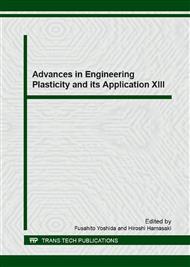p.55
p.60
p.66
p.72
p.77
p.82
p.88
p.94
p.99
A Study on Tensile Deformation Behavior in Fe-Based Shape Memory Alloy by Rate Sensitive Transformation Kinetics Model
Abstract:
Fe-based shape memory alloy (Fe-SMA) shows a shape memory effect (SME) governed by forward and reverse stress-induced martensitic transformation (SIMT). Fe-SMA has been applied to joints and dampers utilized at various strain rates. To utilize Fe-SMA better, it is necessary to understand the mechanical properties in a wide range of strain rate. In previous study, the results of a tensile test at various strain rates show a rate-sensitivity, however, the mechanism of rate-sensitive tensile deformation behavior is still unclear. Thus, a numerical simulation using a transformation kinetics model is needed to clarify the mechanism. Some transformation kinetics models have been proposed, however, the rate sensitivity cannot be included. In this study, the rate sensitivity of volume fraction martensite is considered into the transformation kinetics model as an improvement of the past-proposed model. The numerical simulation of the uniaxial tensile test at various strain rates is performed to reproduce transformation behavior of the martensite phase. Then, the model is validated by comparing to the experimental results. Afterwards, the mechanism of rate-sensitive tensile deformation behavior of Fe-SMA is discussed.
Info:
Periodical:
Pages:
77-81
Citation:
Online since:
December 2016
Authors:
Price:
Сopyright:
© 2017 Trans Tech Publications Ltd. All Rights Reserved
Share:
Citation:


